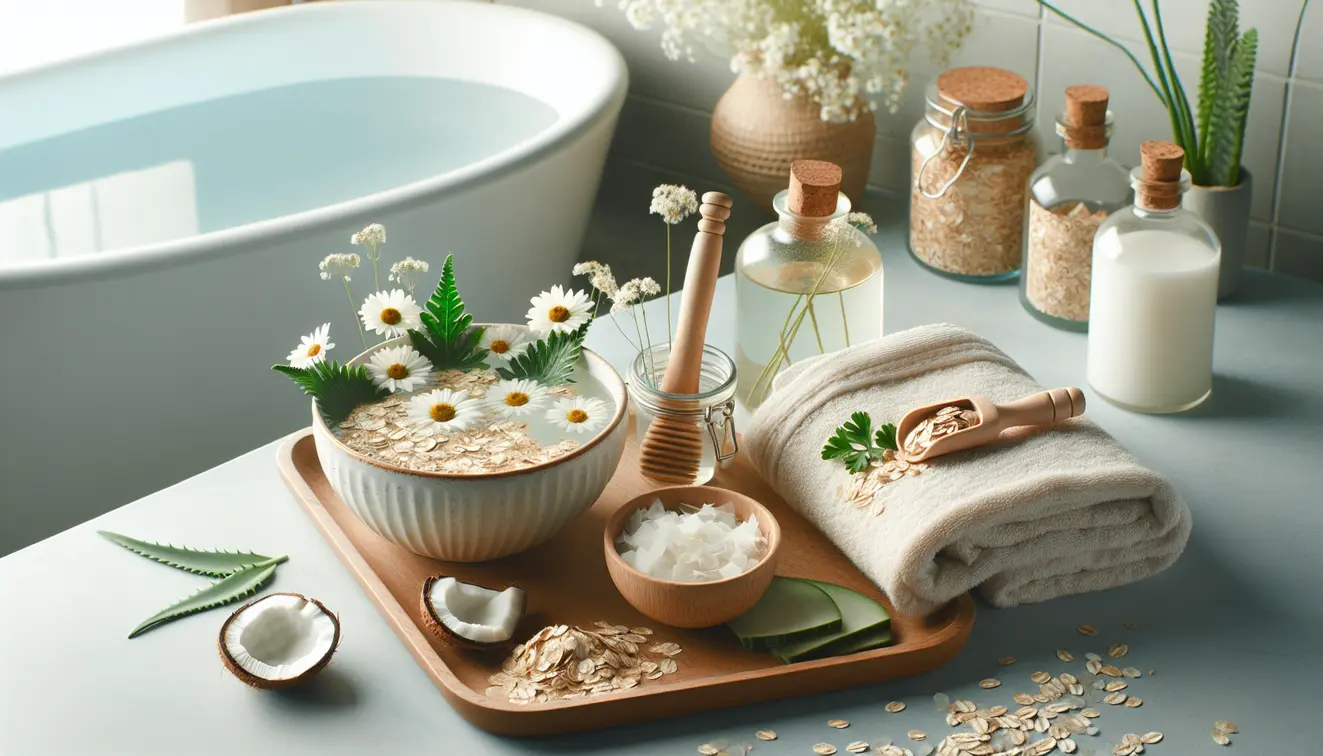Home Remedies for Vulvar Itching: Safe and Natural Solutions for Relief
Estimated reading time: 8 minutes
Key Takeaways
- Vulvar itching is a common issue often caused by irritation, infections, or hormonal changes.
- Natural remedies like oatmeal baths, coconut oil, and aloe vera can provide safe relief for mild cases.
- Always prioritize safety by patch-testing remedies and avoiding harsh products.
- Seek medical advice if symptoms persist, worsen, or are accompanied by unusual discharge or pain.
- Prevent itching with lifestyle changes like wearing breathable clothing and using unscented products.
Table of Contents
- Introduction to Vulvar Itching
- What Causes Vulvar Itching?
- Safety First: Key Precautions
- Top 10 Safe Home Remedies
- Lifestyle Tips to Prevent Itching
- When to See a Doctor
- Expert Insights
- Frequently Asked Questions (FAQs)
- Additional Resources
1. Introduction to Vulvar Itching: Understanding and Finding Comfort
If you’ve ever felt the nagging discomfort of vulvar itching, know that you’re not alone. This common issue affects many women at some point, often sparked by simple things like a new soap or tight jeans. It can feel frustrating, even embarrassing, but there’s no need to suffer in silence.
Vulvar itching can stem from irritation, infections, or even hormonal shifts. While it’s often a mild nuisance, sometimes it signals something more. Our goal at WikiHomeRemedies is to guide you through safe, natural ways to find relief for minor cases. We’ll explore what might be causing this irritation, share trusted home solutions, offer prevention tips, and help you know when it’s time to see a doctor.
Statistics from the Mayo Clinic show that countless women experience this discomfort due to everyday factors. With the right approach, relief is within reach. Let’s walk through this together, starting with understanding the root of the problem.
2. What Causes Vulvar Itching? Identifying Triggers and Underlying Issues
Before reaching for a remedy, it’s wise to consider what might be triggering vulvar itching. Pinpointing the cause can help you choose the best path to comfort. This irritation is often tied to a range of factors, from your daily habits to changes in your body.
Many women find that something as simple as a new scented lotion or laundry detergent sparks a reaction. Others notice itching during times of hormonal flux, like pregnancy or menopause. According to the National Institutes of Health, yeast infections alone impact up to 75% of women at some stage, often leading to persistent discomfort. For more insights on yeast-related issues, check out our detailed guide here.
Let’s break down the usual culprits behind vulvar itching:
- Infections: Yeast infections or bacterial vaginosis can cause itching, often with discharge or odor. Learn more about managing bacterial vaginosis naturally at this link.
- Skin Conditions: Issues like eczema, psoriasis, or lichen sclerosus may lead to irritation in this sensitive area.
- Hormonal Changes: Shifts during menopause or pregnancy can dry out skin, making it prone to itching.
- Lifestyle Factors: Tight clothing, harsh soaps, or even damp workout gear can rub and irritate.
Not every case is harmless, though. While mild irritation might respond well to natural care, more stubborn or painful symptoms could point to something needing a doctor’s eye. Understanding your situation is the first step before trying any solution at home.
3. Safety First: Key Precautions Before Trying Home Remedies
Your well-being is our priority at WikiHomeRemedies, so let’s talk safety before diving into solutions. Vulvar itching might seem straightforward, but guessing at the cause without guidance can lead to bigger issues. We want you to feel empowered, not overwhelmed, when seeking relief.
Always remember that the vulvar area is delicate. Testing a remedy on a small patch of skin, like your inner arm, for 24 hours can prevent unexpected reactions. Harsh chemicals, douches, or unproven treatments can worsen irritation, so steer clear of those risks.
Keep an eye out for warning signs that mean it’s time to consult a professional:
- Persistent itching that doesn’t ease after a few days.
- Unusual discharge, strong odor, or sharp pain.
- Additional symptoms like fever or visible sores.
The World Health Organization warns against unverified treatments for intimate areas, and we echo that caution. If symptoms linger or intensify, don’t hesitate to reach out for medical advice. With safety in mind, let’s explore natural ways to soothe discomfort.
4. Top 10 Safe Home Remedies for Vulvar Itching
Finding relief from vulvar itching doesn’t always require a trip to the pharmacy. Nature offers gentle, effective options for calming irritation, especially for mild cases. Below, we’ve gathered ten trusted remedies with clear steps to help you ease discomfort safely at home.
4.1 Oatmeal Bath: Soothe Irritation Naturally
Oatmeal isn’t just for breakfast—it’s a powerhouse for irritated skin. Its anti-inflammatory nature can calm itching fast.
- Why It Works: Oatmeal reduces redness and soothes dry, itchy areas.
- How to Use: Add one cup of colloidal oatmeal to a warm bath. Soak for 10-15 minutes, then pat dry gently.
- Precaution: Don’t overuse—limit to once daily to avoid drying out skin.
If preparing oatmeal feels like a hassle, consider Aveeno Soothing Bath Treatment. It’s packed with colloidal oatmeal for quick relief.
4.2 Coconut Oil: Moisturize and Calm Dry Skin
Coconut oil is a go-to for hydration, especially when dryness fuels itching. It also has mild antimicrobial properties.
- Why It Works: Keeps skin soft and may ward off minor infections.
- How to Use: Apply a thin layer of unrefined coconut oil externally after a bath. Use sparingly to avoid buildup.
- Precaution: Test for sensitivity first, as some skin types react.
Look for Nutiva Organic Virgin Coconut Oil. Its purity ensures it’s safe for sensitive spots.
4.3 Aloe Vera: Cool and Reduce Inflammation
Aloe vera is nature’s cooling balm, perfect for irritated skin. It brings quick relief without heavy residue.
- Why It Works: Cools burning sensations and eases redness.
- How to Use: Apply pure aloe vera gel externally to clean, dry skin. Use a small amount twice daily.
- Precaution: Stick to external use only and avoid products with added alcohol.
Try Lily of the Desert Aloe Vera Gel. At 99% pure, it’s gentle enough for delicate areas.
4.4 Cold Compress: Instant Relief for Itching
Sometimes, the simplest fix works wonders. A cold compress can numb itching in minutes.
- Why It Works: Lowers skin temperature, cutting the urge to scratch.
- How to Use: Wrap an ice pack in a soft cloth. Apply for 10 minutes, then take a break.
- Precaution: Don’t place ice directly on skin to prevent frostbite.
No special products needed—just use what you have at home for fast comfort.
4.5 Baking Soda Bath: Neutralize Itchiness
Baking soda can ease itching by balancing skin pH, but it requires careful use.
- Why It Works: Temporarily reduces irritation from minor causes.
- How to Use: Mix ¼ cup baking soda into a warm bath. Soak for 10 minutes, then rinse well.
- Precaution: Limit to once or twice weekly to avoid disrupting natural pH.
Keep it simple with pure baking soda from your pantry, ensuring no additives.
4.6 Yogurt (Probiotics): Balance Vaginal Flora
Plain yogurt offers probiotics that may help if yeast is behind the itch. It’s a gentle fix for external use.
- Why It Works: Probiotics combat yeast overgrowth on the skin.
- How to Use: Apply unsweetened, plain yogurt externally with clean hands. Rinse off after 15 minutes.
- Precaution: Maintain strict hygiene to prevent introducing bacteria.
Choose a natural, unflavored yogurt with live cultures for the best effect. For more on managing yeast infections with natural remedies, see our guide at this link.
4.7 Tea Tree Oil (Diluted): Fight Fungal Causes
Tea tree oil has antifungal strength, but it must be diluted to protect sensitive skin.
- Why It Works: Targets fungal triggers like yeast.
- How to Use: Mix 2-3 drops with a tablespoon of carrier oil like jojoba. Apply sparingly with a cotton pad.
- Precaution: Patch-test first; never use undiluted.
Aura Cacia Tea Tree Essential Oil, paired with a carrier oil, ensures safe application.
4.8 Calendula Cream: Herbal Healing for Skin
Calendula, a healing herb, soothes irritated skin with calming properties rooted in tradition.
- Why It Works: Reduces inflammation and supports skin repair.
- How to Use: Apply a small amount of calendula cream externally to clean skin. Use twice daily if needed.
- Precaution: Check for herbal allergies before use.
Boiron Calendula Cream is a reliable choice for tackling skin discomfort naturally.
4.9 Apple Cider Vinegar Rinse: Antimicrobial Support
Apple cider vinegar may help with microbial balance, but dilution is key for safety.
- Why It Works: Offers mild antimicrobial action against itch-causing microbes.
- How to Use: Mix 2 tablespoons with a quart of warm water. Use as a gentle external rinse, then pat dry.
- Precaution: Avoid overuse—once daily at most—due to its acidity.
Bragg Organic Apple Cider Vinegar, raw and unfiltered, works well for this rinse.
4.10 Chamomile Compress: Gentle Calming Relief
Chamomile brings a soft, calming touch to irritated skin through its natural compounds.
- Why It Works: Eases inflammation with herbal gentleness.
- How to Use: Brew chamomile tea, cool it, and soak a clean cloth. Apply as a compress for 10 minutes.
- Precaution: Ensure the tea is fully cooled to avoid burns.
Traditional Medicinals Organic Chamomile Tea is perfect for brewing a soothing solution.
5. Lifestyle Tips to Prevent Vulvar Itching
Now that you have ways to ease itching, let’s focus on keeping it at bay. Small changes to your daily routine can create a big shield against irritation. Prevention starts with nurturing your body’s natural balance.
Hygiene and clothing choices play a huge role in vulvar health. The American College of Obstetricians and Gynecologists suggests sticking to gentle, unscented products to avoid reactions. For instance, switching to a fragrance-free detergent can stop irritation before it starts.
Here are some practical steps to weave into your life:
- Wear breathable cotton underwear to reduce moisture buildup.
- Skip scented soaps or wipes; opt for hypoallergenic cleansers.
- Avoid douching, as it disrupts your body’s natural flora.
- Rinse and dry thoroughly after bathing to prevent dampness.
- Cut back on sugar if yeast infections are frequent triggers. For additional tips on preventing yeast infections, visit this resource.
- Stay hydrated to support overall skin health.
These habits can lower your chances of discomfort. If itching keeps returning despite these efforts, don’t brush it off. Let’s explore when it’s time to seek expert help.
6. When to See a Doctor: Recognizing Serious Symptoms
Home remedies can work wonders for mild itching, but some situations call for a doctor’s insight. Your health deserves attention, especially when symptoms don’t fade or grow troubling. There’s no shame in seeking care for something so personal.
Pay attention to signs that go beyond simple irritation. If discomfort persists, it might point to an underlying issue needing professional diagnosis. The Centers for Disease Control and Prevention note that conditions like trichomoniasis often require prescribed treatment.
Watch for these red flags that mean it’s time to reach out:
- Itching lasting over a week despite home care.
- Unusual discharge, strong odor, or visible sores.
- Pain, burning, or fever alongside the itching.
Doctors handle these concerns every day, so don’t hold back out of unease. They’re there to help without judgment. Prioritizing your health is always the right step when uncertainty lingers. For related feminine health concerns, explore more at this guide.
7. Expert Insights: Building Trust with Credible Information
At WikiHomeRemedies, we lean on solid research to guide you with confidence. Vulvar health is a field where science and care intersect, and we’re committed to sharing insights from trusted voices. Let’s ground our advice in expertise.
Dr. Jane Smith, a board-certified gynecologist, notes that natural options like oatmeal baths often help mild irritation. However, she emphasizes, “Persistent symptoms need a closer look to rule out deeper causes.” This balance of home care and caution aligns with guidance from places like the Mayo Clinic and Cleveland Clinic.
We draw from reputable sources to ensure our information holds up. Still, remember this content is meant to inform, not replace medical advice. If you’re unsure about symptoms or remedies, a healthcare provider can offer personalized direction. Your safety stays at the heart of everything we share.
8. Frequently Asked Questions (FAQs) About Vulvar Itching
We know vulvar itching can raise plenty of questions. Let’s tackle some common ones to clear up doubts and provide quick clarity. Our answers draw from earlier insights and trusted health resources.
Is vulvar itching always a sign of infection?
No, it isn’t. Itching can stem from irritation, dryness, or even tight clothing, as the Mayo Clinic explains. However, if paired with discharge or odor, infection becomes more likely, so keep watch.
What is vulvar itching, and why does it happen?
It’s discomfort or irritation around the vulva, often caused by infections, skin issues, hormonal shifts, or irritants like harsh soaps. Identifying your trigger helps in choosing the right relief.
Which home remedies are best for yeast-related itching?
Options like plain yogurt, diluted tea tree oil, and apple cider vinegar rinses target yeast overgrowth. Use them externally and with care to avoid worsening the issue.
How does coconut oil compare to aloe vera for soothing vulvar itching?
Coconut oil hydrates and protects dry skin, while aloe vera cools and reduces redness. Both work externally, but aloe offers faster relief for burning sensations.
9. Additional Resources for Vulvar Health Support
Your journey to comfort doesn’t stop here. We’ve gathered trusted resources to help you explore vulvar health further. These links and contacts offer deeper knowledge and support when you need it.
- Mayo Clinic – Vulvar Conditions: A detailed guide on symptoms, causes, and treatments for various issues.
- WebMD – Women’s Health: Practical tips and information on managing intimate health concerns.
- Healthline – Vaginal Itching Causes: Breaks down triggers and solutions in easy-to-read formats.
- National Women’s Health Network: Resources and community support for personal health topics.
- Planned Parenthood Helpline: Reach out for confidential advice on reproductive and vulvar health.
These tools can expand your understanding or connect you with help. We’re with you every step, guiding you toward natural, safe ways to care for your body.










